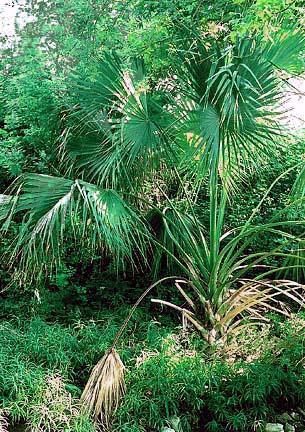|
In the summer of 2003 some 400 Texas Palmettos (Sabal mexicana; also Rio Grande palmetto) were thriving along Waller Creek between Hemphill Park and the south edge of the UT campus. When Texas palm authority Landon Lockett suggested that I check out reports of palmettos along campus stretches of Waller Creek I had no idea of the surprises that lay ahead. As a frequent visitor of the creek in the 60s, I knew that palmettos would have to be of recent origin. I was familiar with our local Dwarf Palmetto (Sabal minor) at Palmetto Park and in the hills just west of Austin. There had been student reports of Dwarf Palmettos in the creek and Landon had recently introduced me to the large population of Texas Palmettos in the Hyde Park neighborhood just north of campus.
I expected to find a few plants, perhaps of both species, and if Texas Palmettos, then perhaps as Hyde Park 'escapees.'
I began my search from the south edge of campus, by the tennis courts at Trinity and MLK. I was astonished to find two 15 foot tall Texas Palmettos, one with a trunk of over 4 feet, just west of the Trinity bridge; and a third large palm with a 28 inch trunk at the footbridge behind the tennis courts. There could be no stopping until I had done the whole creek.

Largest Campus Texas Palmetto
When my survey was completed, I had found only Texas Palmettos — no Dwarf Palmettos had turned up. (How did I know that they were not Dwarf Palmettos?) Further, the evidence from areal distribution and size ranges supports my conclusion that many of these are most probably from large palms in two local sources — (1) palms originally introduced for landscaping at the Austin Presbyterian Seminary north of Speedway and (2) the tall palm beside the Arno Nowotny Building at MLK and I35.
But I have recently learned that a former botany student, Doug Goldman, in the late 1990s distributed large quantities of palm fruits along the same course of Waller that I had surveyed, as well as elsewhere. He reports:
I threw seeds all over the place, along lots of
creeks in "older" parts of Austin.
Certainly a number of these have succeeded, and were counted among the smaller palms in my survey. Determining the origin of the entire Waller palm population would be a challenging task. Others may have done the same thing, both before and after Doug. A well established trunked Washingtonia filifera (desert fan palm) has subsequently appeared at the 24th Street bridge — it was not there in 2003 and has certainly not grown from seed or a small plant the past 5 years.
|

